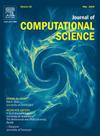Augmenting MRI scan data with real-time predictions of glioblastoma brain tumor evolution using faster exponential time integrators
IF 3.1
3区 计算机科学
Q2 COMPUTER SCIENCE, INTERDISCIPLINARY APPLICATIONS
引用次数: 0
Abstract
We present a MATLAB code for exponential integrators method simulating the glioblastoma tumor growth. It employs the Fisher–Kolmogorov diffusion–reaction tumor brain model with logistic growth. The input is the MRI scans of the human head and the initial tumor location. The simulation uses the finite difference formulation in space and the ultra-fast exponential integrators method in time. The output from the code is the input data for ParaView visualization. While there are many brain tumor simulation codes, our method’s novelty lies in its implementation using exponential integrators. We propose a new algorithm for the fast computation of exponential integrators. Regarding execution time on a laptop with Win10, using MATLAB, with 11th Gen Intel(R) Core(TM) i5-11500H, 2.92 GHz, and 32 GB of RAM, the algorithm outperforms the state-of-the-art routines from Al-Mohy and Higham (2011). We also compare our method with an implicit, unconditionally stable Crank–Nicolson time integration scheme based on the finite difference method. We show that our method is two orders of magnitude faster than the Crank–Nicolson method with finite difference discretization in space on a laptop equipped with MATLAB. The brain tumor two-year future prediction using computational grid and 100-time steps, built over the MRI scans of the human head, takes less than 15 minutes on the laptop.
增强MRI扫描数据与实时预测胶质母细胞瘤脑肿瘤演变使用更快的指数时间积分器
给出了指数积分法模拟胶质母细胞瘤肿瘤生长的MATLAB代码。它采用Fisher-Kolmogorov扩散-反应肿瘤脑模型。输入是人类头部的核磁共振扫描和最初的肿瘤位置。仿真在空间上采用有限差分公式,在时间上采用超快指数积分法。代码的输出是ParaView可视化的输入数据。虽然有许多脑肿瘤模拟代码,但我们的方法的新颖之处在于它使用指数积分器实现。提出了一种快速计算指数积分器的新算法。关于Win10笔记本电脑上的执行时间,使用MATLAB,使用第11代Intel(R) Core(TM) i5-11500H, 2.92 GHz和32gb RAM,该算法优于Al-Mohy和Higham(2011)的最先进例程。并将该方法与基于有限差分法的隐式无条件稳定的Crank-Nicolson时间积分格式进行了比较。在装有MATLAB的笔记本电脑上,我们的方法比空间有限差分离散的Crank-Nicolson方法快两个数量级。利用132×132×132计算网格和100次步进,在人脑核磁共振扫描的基础上,对脑肿瘤两年的未来进行预测,在笔记本电脑上只需不到15分钟。
本文章由计算机程序翻译,如有差异,请以英文原文为准。
求助全文
约1分钟内获得全文
求助全文
来源期刊

Journal of Computational Science
COMPUTER SCIENCE, INTERDISCIPLINARY APPLICATIONS-COMPUTER SCIENCE, THEORY & METHODS
CiteScore
5.50
自引率
3.00%
发文量
227
审稿时长
41 days
期刊介绍:
Computational Science is a rapidly growing multi- and interdisciplinary field that uses advanced computing and data analysis to understand and solve complex problems. It has reached a level of predictive capability that now firmly complements the traditional pillars of experimentation and theory.
The recent advances in experimental techniques such as detectors, on-line sensor networks and high-resolution imaging techniques, have opened up new windows into physical and biological processes at many levels of detail. The resulting data explosion allows for detailed data driven modeling and simulation.
This new discipline in science combines computational thinking, modern computational methods, devices and collateral technologies to address problems far beyond the scope of traditional numerical methods.
Computational science typically unifies three distinct elements:
• Modeling, Algorithms and Simulations (e.g. numerical and non-numerical, discrete and continuous);
• Software developed to solve science (e.g., biological, physical, and social), engineering, medicine, and humanities problems;
• Computer and information science that develops and optimizes the advanced system hardware, software, networking, and data management components (e.g. problem solving environments).
 求助内容:
求助内容: 应助结果提醒方式:
应助结果提醒方式:


